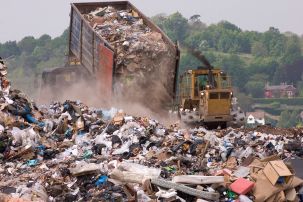Lesson summary
In this activity, students examine and weigh the waste that has been collected over one week from the teacher’s household. They will also bring to class one item of packaging that they think is excessive. Students will then be asked to think critically about the amount of packaging that is used to wrap the things we use every day, and to think creatively about how this packaging could be reused. This activity is in two parts and requires some preparation to collect one week’s worth of rubbish and examples of excessive packaging.
Learning intentions:
Students will...
- learn that we create a lot of waste in our daily lives
- understand that we can recycle much of this waste
- understand that we can think carefully about what we buy so that we aren’t contributing unnecessarily to the waste problem.
Lesson guides and printables
Lesson details
Curriculum mapping
Australian Curriculum content descriptions:
Year 7 Mathematics:
- Investigate, interpret and analyse graphs from authentic data (ACMNA180)
Year 7 Science:
- Some of Earth’s resources are renewable, but others are non-renewable (ACSSU116)
- Collaboratively and individually plan and conduct a range of investigation types, including fieldwork and experiments, ensuring safety and ethical guidelines are followed (ACSIS125)
Year 8 Mathematics:
- Choose appropriate units of measurement for area and volume and convert from one unit to another (ACMMG195)
Year 8 Science:
- Collaboratively and individually plan and conduct a range of investigation types, including fieldwork and experiments, ensuring safety and ethical guidelines are followed (ACSIS140)
- Construct and use a range of representations, including graphs, keys and models to represent and analyse patterns or relationships, including using digital technologies as appropriate (ACSIS144)
- Summarise data, from students’ own investigations and secondary sources, and use scientific understanding to identify relationships and draw conclusions (ACSIS145)
Syllabus Outcomes: SC4-5WS, SC4-6WS, SC4-7WS, SC4-12ES.
Time required: 60 mins
Level of teacher scaffolding: High – collect waste items, assist students in activity.
Resources required
- Waste items for one week (teacher to collect)
- Large buckets
- Plastic bags scales
- Writing materials
- Graph paper
- Art and craft materials.
- Access to the Internet
Additional info
This is an original Cool.org lesson. Facts and figures in these lessons may have changed since this lesson was published. We always endeavour to update our resources in a timely manner, but if you see an error or issue in our resources please get in touch with us.


Welcome back!
Don't have an account yet?
Log in with:
By signing up to Cool.org you consent and agree to Cool's privacy policy to
store, manage and process your personal information. To read more, please see
our privacy policy here(Opens in new tab).
Create your free Cool.org account.
Many of our resources are free, with an option to upgrade to Cool+ for premium content.
Already have an account?
Sign up with:
By signing up to Cool.org you consent and agree to Cool's privacy policy to
store, manage and process your personal information. To read more, please see
our privacy policy here(Opens in new tab).